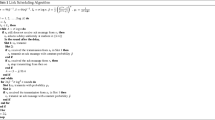Abstract
In this paper we study a dynamic version of capacity maximization in the physical model of wireless communication. In our model, requests for connections between pairs of points in Euclidean space of constant dimension d arrive iteratively over time. When a new request arrives, an online algorithm needs to decide whether or not to accept the request and to assign one out of k channels and a transmission power to the request. Accepted requests must satisfy constraints on the signal-to-interference-plus-noise (SINR) ratio. The objective is to maximize the number of accepted requests.
Using competitive analysis we study algorithms using distance-based power assignments, for which the power of a request relies only on the distance between the points. Such assignments are inherently local and particularly useful in distributed settings. We first focus on the case of a single channel. For request sets with spatial lengths in [1,Δ] and duration in [1,Γ] we derive a lower bound of Ω(Γ⋅Δd/2) on the competitive ratio of any deterministic online algorithm using a distance-based power assignment. Our main result is a near-optimal deterministic algorithm that is O(Γ⋅Δ(d/2)+ε)-competitive, for any constant ε>0.
Our algorithm for a single channel can be generalized to k channels. It can be adjusted to yield a competitive ratio of O(k⋅Γ 1/k′⋅Δ(d/2k″)+ε) for any factorization (k′,k″) such that k′⋅k″=k. This illustrates the effectiveness of multiple channels when dealing with unknown request sequences. In particular, for Θ(log Γ⋅log Δ) channels this yields an O(log Γ⋅log Δ)-competitive algorithm. Additionally, we show how this approach can be turned into a randomized algorithm, which is O(log Γ⋅log Δ)-competitive even for a single channel.
Similar content being viewed by others
References
Andrews, M., & Dinitz, M. (2009). Maximizing capacity in arbitrary wireless networks in the SINR model: Complexity and game theory. In Proc. 28th IEEE conf. computer communications (INFOCOM).
Assouad, P. (1983). Binary contraction of graphs. Discrete Mathematics, 47, 315–319.
Avin, C., Lotker, Z., & Pignolet, Y. A. (2009). On the power of uniform power: capacity of wireless networks with bounded resources. In Proc. 17th European symposium on algorithms (ESA) (pp. 373–384).
Balakrishnan, H., Barrett, C. L., Kumar, V. A., Marathe, M. V., & Thite, S. (2004). The distance-2 matching problem and its relationship to the MAC-layer capacity of ad hoc wireless networks. IEEE Journal of Selected Areas in Communications, 22(6), 1069–1079.
Chafekar, D., Kumar, V. S. A., Marathe, M. V., Parthasarathy, S., & Srinivasan, A. (2008). Approximation algorithms for computing capacity of wireless networks with SINR constraints. In Proc. 27th IEEE conf. computer communications (INFOCOM) (pp. 1166–1174).
Clarkson, K. L. (1999). Nearest neighbor queries in metric spaces. Discrete & Computational Geometry, 22(1), 63–93.
Clarkson, K.L. (2006). Nearest-neighbor search and metric space dimensions. In G. Shakhnarovich, T. Darell, & P. Indyk (Eds.), Nearest-neighbor methods for learning and vision: theory and practice (pp. 15–59). Cambridge: MIT Press.
Fanghänel, A., Kesselheim, T., Räcke, H., & Vöcking, B. (2009). Oblivious interference scheduling. In Proc. 28th symp. principles of distributed computing (PODC) (pp. 220–229).
Fanghänel, A., Kesselheim, T., & Vöcking, B. (2009). Improved algorithms for latency minimization in wireless networks. In Proc. 36th intl. colloq. automata, languages and programming (ICALP) (Vol. 2, pp. 208–219).
Goussevskaia, O., Halldórsson, M. M., Wattenhofer, R., & Welzl, E. (2009). Capacity of arbitrary wireless networks. In Proc. 28th IEEE conf. computer communications (INFOCOM).
Goussevskaia, O., Oswald, Y. A., & Wattenhofer, R. (2007). Complexity in geometric SINR. In Proc. 8th intl. symp. mobile ad-hoc networking and computing (MOBIHOC) (pp. 100–109).
Gupta, P., & Kumar, P. R. (2000). The capacity of wireless networks. IEEE Transactions on Information Theory, 46, 388–404.
Halldorsson, M. & Wattenhofer, R. 2010 Computing wireless capacity. Unpublished manuscript.
Halldorsson, M. M. (2009). Wireless scheduling with power control. In Proc. 17th European symposium on algorithms (ESA) (pp. 361–372).
Kesselheim, T. (2011). A constant-factor approximation for wireless capacity maximization with power control in the SINR model. In Proc. 22nd symp. discrete algorithms (SODA) (pp. 1549–1559)
Moscibroda, T., & Wattenhofer, R. (2006). The complexity of connectivity in wireless networks. In Proc. 25th IEEE conf. computer communications (INFOCOM) (pp. 1–13).
Moscibroda, T., Wattenhofer, R., Zollinger, A. (2006). Topology control meets SINR: the scheduling complexity of arbitrary topologies. In Proc. 7th intl. symp. mobile ad-hoc networking and computing (MOBIHOC) (pp. 310–321).
Author information
Authors and Affiliations
Corresponding author
Additional information
This work has been supported by DFG through UMIC Research Centre at RWTH Aachen University and grant HO 3831/3-1.
Rights and permissions
About this article
Cite this article
Fanghänel, A., Geulen, S., Hoefer, M. et al. Online capacity maximization in wireless networks. J Sched 16, 81–91 (2013). https://doi.org/10.1007/s10951-011-0227-z
Published:
Issue Date:
DOI: https://doi.org/10.1007/s10951-011-0227-z




